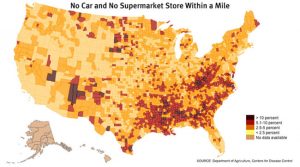When I was in college, I lived closer to three different chemical plants than I did to a single grocery store. To regularly get healthy, fresh fruits and vegetables into my diet, I had to drive nearly 20 minutes. To my friends from rural communities, this was commonplace. However, living in the capital city of Louisiana, it’s hard to understand why this is the case.
The U.S. Department of Agriculture defines food deserts as “areas in the United States with limited access to affordable and nutritious food, particularly such an area composed of predominantly lower-income communities.”
Urban food deserts tend to be neighborhoods where there is no grocery store within a one-mile radius, or where many members of the community do not have personal vehicles and have to rely on public transportation — if that is available. For some with the privilege of living near grocery stores, this idea is often hard to fathom. However, there are hundreds of large cities across the country where people simply do not have access to healthy and affordable fresh produce.

A study done in Baton Rouge, Louisiana, for example, found that nearly a quarter (23 percent) of East Baton Rouge Parish residents lived in food deserts. These neighborhoods tend to have higher populations of Black people, indigenous people, and people of color. In this same study, most of the high-priority Baton Rouge zip codes identified were 85 percent or more African American.
Researchers have pointed to how much our neighborhood’s food landscape impacts our health. Those living in food desert communities often experience higher rates of chronic illness like obesity, diabetes, and high blood pressure.
There are stories of mothers who have to take several buses to get to a grocery store to feed their families healthy food. For many people, this means traveling nearly an hour one way just to get someplace that sells fresh produce.
One may wonder how this is such a big deal, especially if you live in a rural community where longer travel times are the norm. But in urban communities, this often also means fight through “food swamps,” where fast-food restaurants and corner stores exist at every block of your community. With so many fast-food restaurants and so few grocery stores and fresh food markets, many across the country struggle to meet their basic needs. Eating healthy means traveling far, paying more, and sacrificing time and energy. And both the data and the lived experiences of communities reveal to us a deeper story.
Recently, activists and scholars have begun to use the term food apartheid, rather than food desert, to describe these situations, as this new term takes into account the social inequalities in place in the nation’s food system. The word “desert” implies that these food landscapes are natural. The word “apartheid” looks at the food system holistically and aims to shed a light on the racial, geographic, social, and economic components that have contributed to low-income communities and communities of color experiencing greater food insecurity.
Food apartheid in America is linked closely to America’s history of racial segregation. Segregation contributed to the root cause of various racial health disparities in the United States. Specifically, “white flight” and the development of the American suburbs in the 1960s led to dis-parities in urban, predominantly Black communities. In hopes of meeting their bottom line, large chain grocery stores tended to follow profitable markets in newly established, higher income White suburbs, where there was more available retail property and access to highways.
Supermarkets avoid urban establishments due to low bank lending, high construction costs and “a declining middle-class population.” They also cited reasons such as fear of safety from criminal activity and inability to difficulty finding retail locations that are large enough or are free from zoning restrictions. This, however, should not be an excuse for millions of people not being able to access fresh produce.
Diversity, inclusion, and activism are necessary in American agriculture for this reason. I think often about how current problems in agriculture are focused around feeding the world’s nearly 8 billion people, yet many communities in the richest country in the world must overcome hurdles to access fresh produce.
Very little has been done nationally to address these injustices at a large scale. This is not merely a political or economic issue. It is a human rights concern. When communities of color and low-income communities are still fighting for access to basic needs, we have a long way to go.
Irene Lewis is a recent Master’s student in the John Glenn College of Public Affairs at The Ohio State University with a major in public administration with a focus on public policy and management. She is a south Louisiana native and food justice and access advocate.



